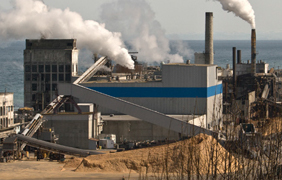Introduction to Electrostatic Precipitators
As you may know, particulate matter (PM) is a common industrial air pollutant that is harmful to human health and must be controlled in order to minimize its harmful effects. In many industrial plants, particulate matter created in the industrial process is carried as dust in the hot exhaust gases. These dust-laden gases pass through an electrostatic precipitator that collects most of the dust. Cleaned gas then passes out of the precipitator and through a stack to the atmosphere. Precipitators typically collect 99.9% or more of the dust from the gas stream.
Particle pollution is not isolated to a few geographic locations or even a few industries; but is pervasive across a wide variety of industries all over the world. In the United States the Environmental Protection Agency (EPA) regulates particulate emissions for various industries, and as a result, provoked industry to respond with various control devices that enable these regulations to be met.
Of the major particulate collection devices available today, electrostatic precipitators (ESPs) are one of the more frequently used options. It is designed to trap and remove dust particles from the exhaust gas stream of an industrial process. These devices depend on electrostatic attraction to capture particles from industrial processes, and are adaptable to many applications. Depending on the design, ESPs are capable of handling large gas volumes across a wide range of temperatures, pressures, dust volumes, and acid gas conditions. They can collect a wide range of particle sizes, in either dry or wet states, and are cable of achieving collection efficiencies greater than 99.5%. Though they are not always the appropriate PM removal solution, they are popular among these industries:
- Power/Electric
- Cement
- Chemicals
- Metals
- Paper
Electrostatic precipitators function by electrically charging PM within a passing gas stream, inducing the particles to be attracted to and deposited on grounded plates or some other grounded collecting surface. When a layer of dust has accumulated, the collectors are shaken to dislodge the particles, causing them to fall with the force of gravity to hoppers below. The collected PM is then removed from the ESP by a conveyor system for disposal or recycling.
Depending upon flue gas chemistry and the gas volume to be treated, there are many different sizes, types and designs of electrostatic precipitators. However, they all operate using the same principles and key components.
Electrostatic precipitation removes particles from the exhaust gas stream of an industrial process. Often the process involves combustion, but it can be any industrial process that would otherwise emit particles to the atmosphere. Six activities typically take place:
- Ionization – Charging of particles
- Migration – Transporting the charged particles to the collecting surfaces
- Collection – Precipitation of the charged particles onto the collecting surfaces
- Charge Dissipation – Neutralizing the charged particles on the collecting surfaces
- Particle Dislodging – Removing the particles from the collecting surface to the hopper
- Particle Removal – Conveying the particles from the hopper to a disposal point
The major precipitator components that accomplish these activities are as follows:
- Discharge Electrodes
- Power Components
- Precipitator Controls
- Rapping Systems
- Purge Air Systems
- Flue Gas Conditioning / Sorbent Injection Systems
Helpful Resources
KnowledgeBase: Major Components Overview
KnowledgeBase: Theory of Operations
KnowledgeBase: Process Influences & Keys to Performance
KnowledgeBase: ESP Maintenance
KnowledgeBase: ESP Troubleshooting


